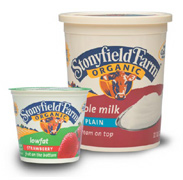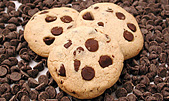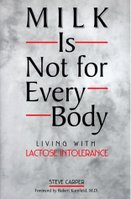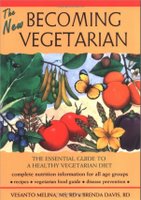I'm a bit late getting to this, but I take Business Week magazine out of the library.
The cover story of their Oct. 16, 2006 issue was The Organic Myth by Diane Brady.
In it Brady details the current state of the organic foods market in the United States and in particular the strain that market is under as businesses try to scale up from tiny farms with small outputs to organics being available in every supermarket in the country.
Here are a few excerpts. I've limited them to discussions of organic milk, since it is often used for organic yogurts and people with lactose intolerance are often told to continue to eat yogurt, as a low-lactose and well-tolerated form of dairy product, to continue to get the calcium they need.
Next time you're in the supermarket, stop and take a look at Stonyfield Farm yogurt.  With its contented cow and green fields, the yellow container evokes a bucolic existence, telegraphing what we've come to expect from organic food: pure, pesticide-free, locally produced ingredients grown on a small family farm.
With its contented cow and green fields, the yellow container evokes a bucolic existence, telegraphing what we've come to expect from organic food: pure, pesticide-free, locally produced ingredients grown on a small family farm.
So it may come as a surprise that Stonyfield's organic farm is long gone. Its main facility is a state-of-the-art industrial plant just off the airport strip in Londonderry, N.H., where it handles milk from other farms. And consider this: Sometime soon a portion of the milk used to make that organic yogurt may be taken from a chemical-free cow in New Zealand, powdered, and then shipped to the U.S. True, Stonyfield still cleaves to its organic heritage. For Chairman and CEO Gary Hirshberg, though, shipping milk powder 9,000 miles across the planet is the price you pay to conquer the supermarket dairy aisle. "It would be great to get all of our food within a 10-mile radius of our house," he says. "But once you're in organic, you have to source globally."
...
Everyone agrees on the basic definition of organic: food grown without the assistance of man-made chemicals. Four years ago, under pressure from critics fretting that the term "organic" was being misused, the U.S. Agriculture Dept. issued rules. To be certified as organic, companies must eschew most pesticides, hormones, antibiotics, synthetic fertilizers, bioengineering, and radiation. But for purists, the philosophy also requires farmers to treat their people and livestock with respect and, ideally, to sell small batches of what they produce locally so as to avoid burning fossil fuels to transport them. The USDA rules don't fully address these concerns.
Hence the organic paradox: The movement's adherents have succeeded beyond their wildest dreams, but success has imperiled their ideals. It simply isn't clear that organic food production can be replicated on a mass scale.
...
Farming without insecticides, fertilizers, and other aids is tough. Laborers often weed the fields by hand. Farmers control pests with everything from sticky flypaper to aphid-munching ladybugs. Manure and soil fertility must be carefully managed. Sick animals may take longer to get well without a quick hit of antibiotics, although they're likely to be healthier in the first place. Moreover, the yield per acre or per animal often goes down, at least initially. Estimates for the decline from switching to organic corn range up to 20%.
...
For a sense of why Big Business and organics often don't mix, it helps to visit Jack and Anne Lazor of Butterworks Farm. The duo have been producing organic yogurt in northeastern Vermont since 1975. Their 45 milking cows are raised from birth and have names like Peaches and Moonlight. All of the food for the cows -- and most of what the Lazors eat, too -- comes from the farm, and Anne keeps their charges healthy with a mix of homeopathic medicines and nutritional supplements. Butterworks produces a tiny 9,000 quarts of yogurt a week, and no one can pressure them to make more. Says Jack: "I'd be happiest to sell everything within 10 miles of here."
But the Lazors also embody an ideal that's almost impossible for other food producers to fulfill. For one thing, they have enough land to let their modest-sized herd graze for food. Many of the country's 9 million-plus dairy cows (of which fewer than 150,000 are organic) are on farms that will never have access to that kind of pasture. After all, a cow can only walk so far when it has to come back to be milked two or three times a day.
When consumers shell out premiums of 50% or more to buy organic, they are voting for the Butterworks ethic. They believe humans should be prudent custodians not only of their own health but also of the land and animals that share it. They prefer food produced through fair wages and family farms, not poor workers and agribusiness. They are responding to tales of caged chickens and confined cows that never touch a blade of grass; talk of men losing fertility and girls becoming women at age nine because of extra hormones in food. They read about pesticides seeping into the food supply and genetically modified crops creeping across the landscape.
For Big Food, consumers' love affair with everything organic has seemed like a gift from the gods. Food is generally a commoditized, sluggish business, especially in basic supermarket staples. Sales of organic groceries, on the other hand, have been surging by up to 20% in recent years. Organic milk is so profitable -- with wholesale prices more than double that of conventional milk -- that Lyle "Spud" Edwards of Westfield, Vt., was able to halve his herd, to 25 cows, this summer and still make a living, despite a 15% drop in yields since switching to organic four years ago. "There's a lot more paperwork, but it's worth it," says Edwards, who supplies milk to Stonyfield.
...
Dairy producers estimate that demand for organic milk is at least twice the current available supply. To quench this thirst, the U.S. would have to more than double the number of organic cows -- those that eat only organic food -- to 280,000 over the next five years. That's a challenge, since the number of dairy farms has shrunk to 60,000, from 334,000 in 1980, according to the National Milk Producers Federation. And almost half the milk produced in the U.S. comes from farms with more than 500 cows, something organic advocates rarely support.
...
Would consumers be willing to pay twice as much for organic milk if they thought the cows producing it spent most of their outdoor lives in confined dirt lots?
Absolutely not, say critics such as Mark Kastel, director of the Organic Integrity Project at the Cornucopia Institute, an advocacy group promoting small family farms. "Organic consumers think they're supporting a different kind of ethic," says Kastel, who last spring released a high-profile report card labeling 11 producers as ethically challenged.
Kastel's report card included Horizon Organic Dairy, the No. 1 organic milk brand in the U.S., and Aurora Organic Dairy, which makes private-label products for the likes of Costco and Safeway Inc. Both dairies deny they are ethically challenged. But the two do operate massive corporate farms. Horizon has 8,000 cows in the Idaho desert. There, the animals consume such feed as corn, barley, hay, and soybeans, as well as some grass from pastureland. The company is currently reconfiguring its facility to allow more grazing opportunities. And none of this breaks USDA rules. The agency simply says animals must have "access to pasture." How much is not spelled out. "It doesn't say [livestock] have to be out there, happy and feeding, 18 hours a day," says Barbara C. Robinson, who oversees the USDA's National Organic Program.
But what gets people like Kastel fuming is the fact that big dairy farms produce tons of pollution in the form of manure and methane, carbon dioxide, and nitrous oxide -- gases blamed for warming the planet. Referring to Horizon's Idaho farm, he adds: "This area is in perpetual drought. You need to pump water constantly to grow pasture. That's not organic."
What do you do as a concerned customer? First, you need to decide what your personal strictures are for organic foods. Are you a diehard supporter of family farms? Are you more concerned that larger farms work to improve their methods? Would you prefer to convert a large percentage of your food buying to organics or are you interested in certain foods that mean the most to you be organic?
If you do want to go all the way, here are a few tips.
*Try limiting your organic shopping to local health food stores rather than supermarkets. Most health or natural food stores need smaller quantities of foods so they can work with local farmers not big enough to supply whole chains.
*Check the websites of the companies for statements on their methods, their products, and their philosophies.
*Look to see whether the company is independent, owned by a larger natural foods company, or owned by a large food conglomerate. Stonybrook Farm, as the article states, is now owned by
Group Danone, the maker of Yoplait and also of many other non-organic brands. Horizon Organic, Rachel's Organic, and Organic Cow of Vermont are all part of Dean Foods, which has been "criticized for running large corporate farms," according to
Business Week.
*Always check for the USDA Organic label on the package.




















